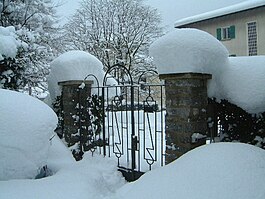Arbedo-Castione
| Arbedo-Castione | ||
|---|---|---|
 |
||
|
||
| Coordinates: 46°13′N 9°03′E / 46.217°N 9.050°ECoordinates: 46°13′N 9°03′E / 46.217°N 9.050°E | ||
| Country | Switzerland | |
| Canton | Ticino | |
| District | Bellinzona | |
| Government | ||
| • Mayor | Sindaco | |
| Area | ||
| • Total | 21.28 km2 (8.22 sq mi) | |
| Elevation | 283 m (928 ft) | |
| Population (Dec 2015) | ||
| • Total | 4,812 | |
| • Density | 230/km2 (590/sq mi) | |
| Postal code | 6517 | |
| SFOS number | 5001 | |
| Surrounded by | Bellinzona, Claro, Gnosca, Gorduno, Lumino, Roveredo (GR), Sant'Antonio | |
| Website |
www SFSO statistics |
|
Arbedo-Castione is a municipality in the district of Bellinzona in the canton of Ticino in Switzerland.
The Early Bronze Age Hoard of Castione (from about 1800 BC.) contains material from north of the Alps. This large find indicates that the area was an important trading and transportation center during the Bronze Age. A Late Bronze Age settlement (from about 1300 BC.) is indicated by evidence of digging and traces of a number of cremation sites. The bulk of the finds come from the five groups of tombs at Castione, Castione-Bergamo, Cerinasca d'Arbedo, Molinazzo d'Arbedo and S. Paolo d'Arbedo, which are dated to the Hallstatt and Latène eras. The tombs were discovered at the end of the 19th Century during the construction of the Gotthard Railway, but probably were only partially excavated. Most of the finds are in Swiss National Museum.
Starting in the 6th Century, both buried cremation urns and full body graves became common, though later only bodies were buried. The cremation ashes were buried in stone cists or pits, while bodies were buried in stone lined tombs under deck plates were made of gneiss. The dead were buried with their possessions (brooches, belts and jewelry). In the Latène era, isolated swords and helmets were added to the men's graves. The women's graves began to contain a number of amber objects, such as earrings and necklaces. Within the grave there were also containers, usually made of clay (pots, bowls, cups, cans), or occasionally bronze (Situlae or beak jugs). While these are a few imports from Etruria (8 beak jug, 1 bucket), most of the items were produced in the area. The large bronze hoard of Arbedo dates from the period around 450 BC. Over 4,000 items were discovered in Arbedo along with smelting furnaces and workshop waste. In addition to local products, there are numerous important Etruscan and northern Alpine objects.
...
Wikipedia



